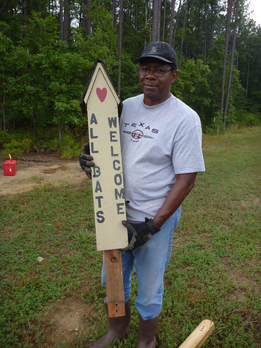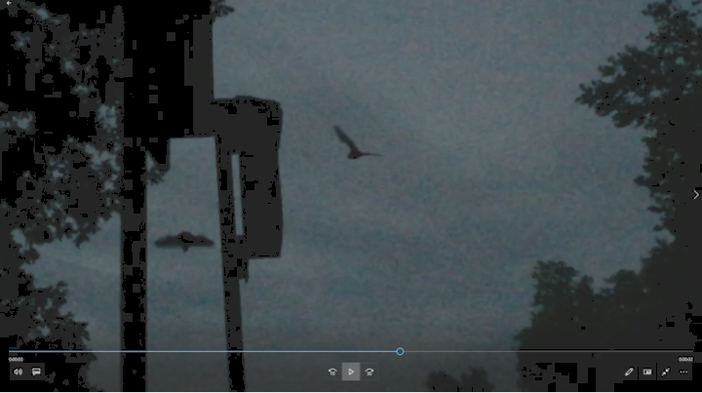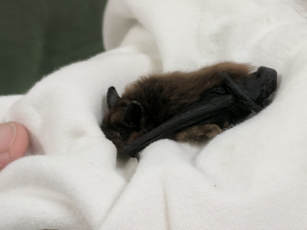Acoustic Monitoring of Bat Populations
 Image of Willie F., VMN volunteer (Pocahontas Chapter), by Liz Revette.
Image of Willie F., VMN volunteer (Pocahontas Chapter), by Liz Revette.
Project Overview and Purpose
In 2018, there are several different bat monitoring projects happening within our VMN chapters. Volunteers may choose to participate in some or all of these activities, depending on which are the best fit for them. In general, the objectives of all the activities are to document local bat populations over time and contribute data to national bat population databases, with an overall goal of contributing to bat conservation efforts. We recommend that you watch the overview video (see Resources), in which the various pros and cons of each approach are described.
To briefly summarize:
- The Historic Rivers Chapter is conducting driving transects using the SonoBat 4 Base with the Pettersson M500 Microphone. Their data are compatible and shared with the North American Bat Monitoring Program (NABat). Generally, these project activities are more stringent and use more expensive equipment, but may be more scientifically rigorous. They are also conducting point counts at bat emergence sites.
- The Pocahontas Chapter is conducting stationary surveys using the Echo Meter Touch. Their data are not currently compatible with NABat, but instead are shared with the Bat Acoustic Monitoring Portal (BatAMP). Generally, these project activities are more accessible and flexible and use less expensive equipment, but may be less scientifically rigorous.
Both approaches and all the associated activities are valuable. The best approach for a given chapter or volunteers depends on time, funds, number of volunteers committed, local interests and goals, and other factors. In addition, Virginia Tech and the Virginia Department of Game and Inland Fisheries may be starting an additional bat monitoring project. We do not yet know the details on that project, but we will add them to this page when we do.
Project Leaders and Contacts
Depending on which project approach you plan to take, you will have a different contact for more information:
Wendy Nelson (Certified Virginia Master Naturalist volunteer, Historic Rivers Chapter)
Liz Revette (Certified Virginia Master Naturalist volunteer, Pocahontas Chapter)
How To Get Involved
We recommend that you take the following steps to get involved:
- Watch the webinar video to understand the various project possibilities, and review all the Project Resources provided on this page.
- Talk to other volunteers in your chapter about the options and decide which project approach you plan to take. You can do _all_ of the activities, but be aware that they require different equipment and protocols.
- Make sure that the project gets approved for your chapter and is listed on the Volunteer Management System as an approved project. There is a sample project proposal form (see Resources) to aid you in this effort.
- Contact one or both of the project contacts (depending on which activities you will do) to get any additional information, recommendations on equipment, etc.
- Get started with your monitoring, and don’t forget to report your data to the appropriate contact!
How To Report Your Hours
If you are participating in this project, please first make sure that the project is approved by your chapter. A project proposal form (encompassing all the monitoring approaches) is provided below to make the process easier. You may edit the proposal to fit your particular chapter’s needs. Once it is approved, the project should be entered into your chapter’s Volunteer Management System so that it appears on the list of project choices.
Project Resources
- Acoustic Bat Monitoring Project proposal form and description (MS Word) – Chapters should edit this document as needed to include local project leaders or other details specific to their chapters.
- Webinar recording – Acoustic Bat Monitoring Projects in Virginia and Beyond: Stream the video below or at video.vt.edu.
For the NABat-style driving survey and emergent counts, from the VMN-Historic Rivers Chapter:
- Historic Rivers Chapter bat monitoring protocols 2018 (MS Word)
- Risk management for bat monitoring driving transects (MS Word)
- Risk management for bat monitoring emergent counts (MS Word)
For the Echo Meter Touch-style stationary counts, from the VMN-Pocahontas Chapter:


